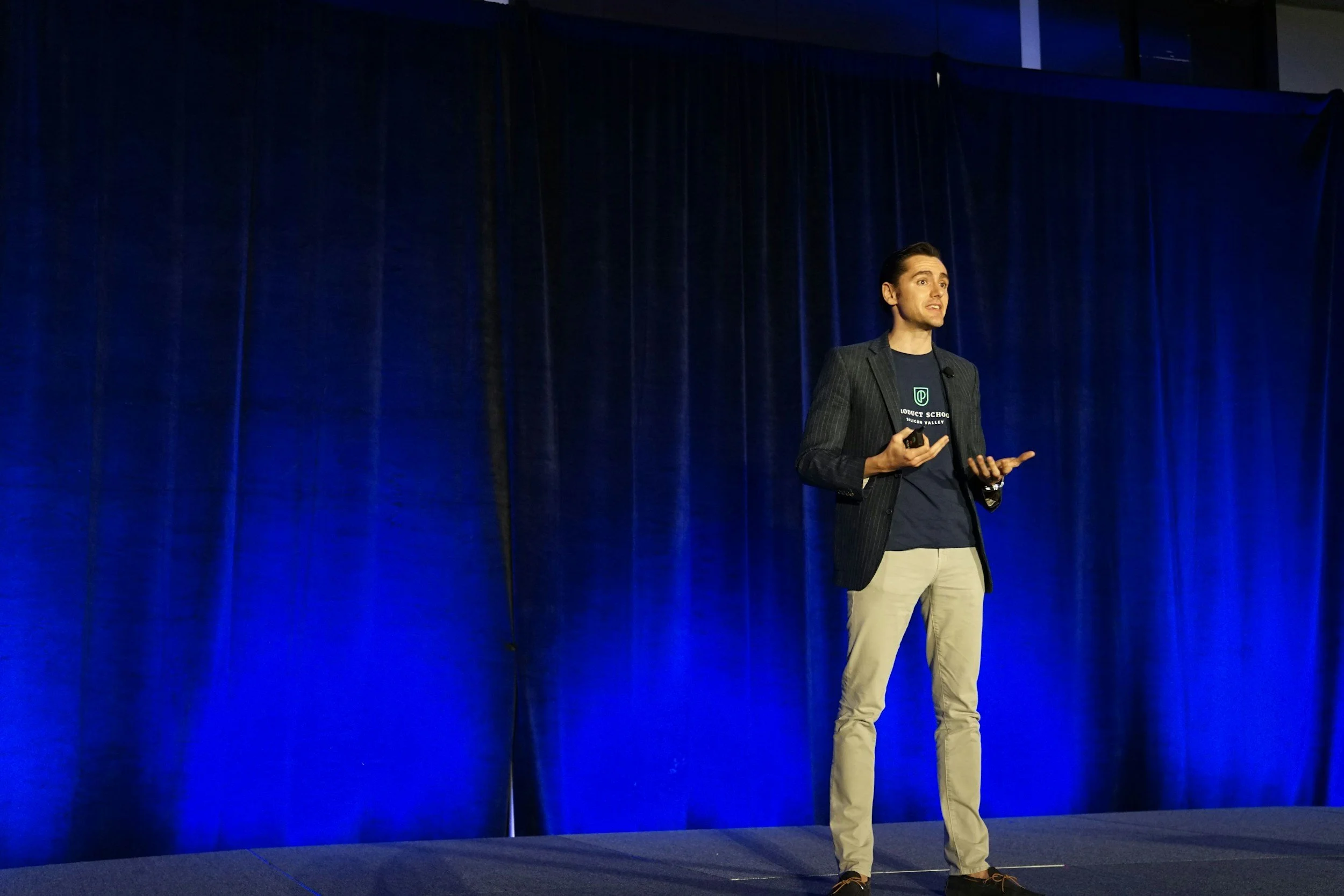How to Deliver a TED Style Talk That Captivates, Connects, and Inspires

Liam Sandford
Liam Sandford is a public speaking coach, marketing leader, and 2x Best Selling Author, including the book Effortless Public Speaking. He helps introverted professionals and leaders take control of public speaking anxiety and use speaking to market themselves, build influence, and communicate with impact.
Delivering a TED style talk is one of the most powerful ways to share an idea that truly matters. These talks have reshaped how we think about presentations, storytelling, and audience connection. They are short, sharp, and unforgettable, a masterclass in how to communicate ideas worth spreading.
Whether you are preparing for a TEDx stage or want to bring that same level of impact to your next presentation, this guide will show you how to design, structure, and deliver your own TED style talk. You will learn what makes TED talks so effective, how to use storytelling to create emotional connection, and how to deliver with presence and authenticity so your audience’s eyes light up.
Why TED Talks Are So Captivating
There is something magnetic about TED talks. They pull you in, one after another, until you have spent an hour deep in a playlist of ideas that challenge how you think. But what makes them so addictive? It comes down to clarity, focus, and emotional connection.
Every TED talk is built around a single idea worth spreading. The speaker’s goal is not to teach everything they know, it is to inspire one meaningful shift in how the audience sees the world. The short format forces precision. With a strict 18-minute time limit, every word must serve the audience. There is no fluff, filler, or wasted time. Every story, metaphor, and example exists to move the message forward.
This brevity creates momentum. When a talk is straight to the point and every sentence delivers value, the audience stays hooked. It is the attention game played at the highest level, and it is won through clarity, storytelling, and empathy.
The 18-Minute Rule: Power in Precision
Eighteen minutes may seem generous at first, but it is deceptively short. Every TED speaker could talk for hours on their subject, yet the time constraint demands focus. This is what makes TED talks so powerful, they are distilled insight, not information overload.
By keeping talks to the point, speakers respect their audience’s time and attention. They cut everything that does not add value. The result is a concentrated message that lands cleanly and memorably. It is a valuable lesson for any speaker: more words do not mean more understanding. Precision always beats volume.
This also trains speakers to serve their audience, not themselves. Everything you include should exist for the audience’s benefit, not as a reminder for you or a showcase of how much you know. The best TED speakers understand that the talk is not about them, it is about the listener.
The Role of Storytelling in TED Style Talks
Storytelling is what transforms a talk from a transfer of knowledge into an emotional experience. It is what makes the audience care. Every great TED talk blends insight with emotion through stories that humanise ideas.
The most memorable talks follow what can be called the up and down pattern of storytelling, moments of tension and struggle followed by resolution and discovery. This rhythm mirrors how people process emotion. The “down” moments create empathy, while the “up” moments create inspiration.
The best stories start with authenticity. You do not need a dramatic life event to create impact, you just need honesty. The audience connects most deeply when they sense truth. When you share vulnerability, reflection, or realisation, it builds trust. That trust is what keeps people listening.
Your story becomes a vessel for your idea. It turns abstract concepts into lived experience, helping your audience not just understand, but feel your message.
The Difference Between TED and TEDx Talks
TED and TEDx share the same DNA but happen on very different stages. TED is the global platform run by the main organisation, where experts, innovators, and storytellers share ideas that reach millions.
TEDx is the local version. It is run by independent teams under a licence from TED, bringing the same format and principles to communities around the world. These events often feature educators, creators, professionals, and people with powerful real-life stories.
The beauty of TEDx is that it opens the door for new voices. It gives people the chance to share their message, test their story, and build momentum on a smaller stage. Many TEDx talks have later been featured on TED.com, but every one of them starts with the same purpose: sharing an idea worth spreading.
Different scale, same mission. Whether TED or TEDx, both are built around storytelling that inspires action and leaves a lasting impact.
Would you like me to flow this version into your “How to Deliver a TED-Style Talk” article now?
Structure: The Secret Framework Behind Great TED Talks
The structure of a TED talk is designed for maximum impact. Interestingly, it mirrors the principles of my Nano Speech framework: opening, body, and close, a model that helps speakers communicate ideas clearly and memorably.
Opening: Capture Attention Immediately
TED speakers rarely open with an agenda. They start with a story, a question, or a surprising fact that hooks the audience instantly. You do not need to begin with “Today I am going to talk about…” Instead, start with a moment that captures curiosity. This first minute sets the emotional tone for everything that follows.
Body: Develop the Idea Through Story and Insight
The body of your talk is where you guide the audience through the journey of discovery. Each section should build towards your main idea. Alternate between emotion and logic, tension and release, data and story. This pattern keeps people emotionally and intellectually engaged.
Close: Inspire Action
Every TED talk ends with a clear, actionable takeaway, a call to action that empowers the audience to do something with what they have learned. This could be a mindset shift, a practical step, or a reflective challenge. The close should create that moment when the audience connects everything you have said and feels genuinely inspired to act.
Slides Are the Supporting Act, Not the Star
Many speakers rely on slides as a crutch, a way to remember what comes next or to offload too much information. TED speakers take the opposite approach. The slides, if used at all, exist purely for the audience’s benefit.
Each slide supports the story. No bullet points, no walls of text, no distraction. Visuals are chosen intentionally to reinforce the key idea or to create an emotional response that words alone cannot. When the slides enhance, not replace, the story, the audience’s attention stays where it belongs: on the speaker.
This design choice changes how you prepare. It forces you to know your content deeply and deliver it naturally. The slides become secondary. The audience connects with you, not your presentation deck.
Speak Without an Agenda: Hook First, Then Deliver
One of the simplest but most powerful lessons from TED talks is this: do not open with an agenda. In business presentations, we are often told to start by listing topics or objectives. But this kills curiosity.
Instead, start with a hook. A question, a personal story, a surprising statement, anything that makes the audience lean in. You can outline your journey once they are engaged, but your first job is to earn their attention.
By the same logic, your close should never fade away. End with a call to action. Give your audience something simple and specific they can do next. When people leave knowing exactly how to apply what they have heard, they carry your message with them long after the talk ends.
How to Sound Effortless on Stage
The best TED speakers appear completely natural, but that ease comes from careful preparation. They do not memorise every line word for word; they master transitions and anchor points so the talk flows organically. This gives them freedom to adapt while maintaining structure.
They also speak for listening, not for reading. Short sentences, natural rhythm, and conversational tone make the talk feel human. It is not a performance, it is a conversation with the world.
Remember: simplicity is not the absence of depth. It is the art of expressing something profound in a way anyone can understand. The more complex your idea, the simpler your delivery should be. If you want to start presenting effortlessly, check out the Ultimate Guide to Public Speaking.
Managing Nerves and Finding Presence
Even the most experienced TED speakers feel nervous before walking on stage. What sets them apart is how they interpret that feeling. Nervousness and excitement produce the same physiological response, faster heartbeat, higher alertness, more energy. The key difference is mindset.
When your body tells you you are scared, reframe it as readiness. Your brain is preparing you to perform at your best. Instead of resisting the feeling, channel it. Ground yourself with steady breathing, visualise success, and focus on serving your audience.
Confidence, as I often say, is success remembered. Every successful talk you give, no matter how small, builds a foundation for the next one. Confidence compounds. Reflect on what went well, not what went wrong. That is how you avoid the circle of doom, the trap of fearing past mistakes instead of building on successes.
How to Deliver Ideas Worth Spreading
A TED style talk is not about performance or perfection. It is about purpose. Your goal is to serve your audience by giving them something valuable, a new perspective, a story that resonates, or a truth that sticks.
To create lasting impact:
Keep your message clear and concise.
Use storytelling to humanise your idea.
Make your slides the supporting act, not the star.
Hook your audience early, and close with a clear call to action.
Channel nerves into energy.
When you combine all these elements with authenticity, empathy, and structure, you can create a talk that does not just inform, it transforms. And when your audience’s eyes light up, you will know your message has truly landed.
TL;DR: Deliver TED Style Talks with Impact
Creating a memorable talk is about clarity, presence, and audience connection, not perfection.
Start with a hook to capture attention immediately and end with a clear call to action.
Sound effortless by preparing anchor points, mastering transitions, and speaking naturally.
Reframe nerves as readiness; channel energy into presence and focus.
Use simplicity, storytelling, and concise messaging to make complex ideas relatable.
Build confidence through reflection on successes and repeated practice, allowing each talk to compound your skill and impact.
More From Liam Sandford
Read my book: Effortless Public Speaking. Learn how to speak confidently, reduce stress, and turn public speaking into your competitive advantage. These actionable public speaking tips will help you improve your presentation skills for any audience.
Join the free 5-day email course: Get daily lessons packed with practical strategies to deliver effective presentations and speak confidently. This course is designed to build your public speaking skills step by step. Sign up below:
